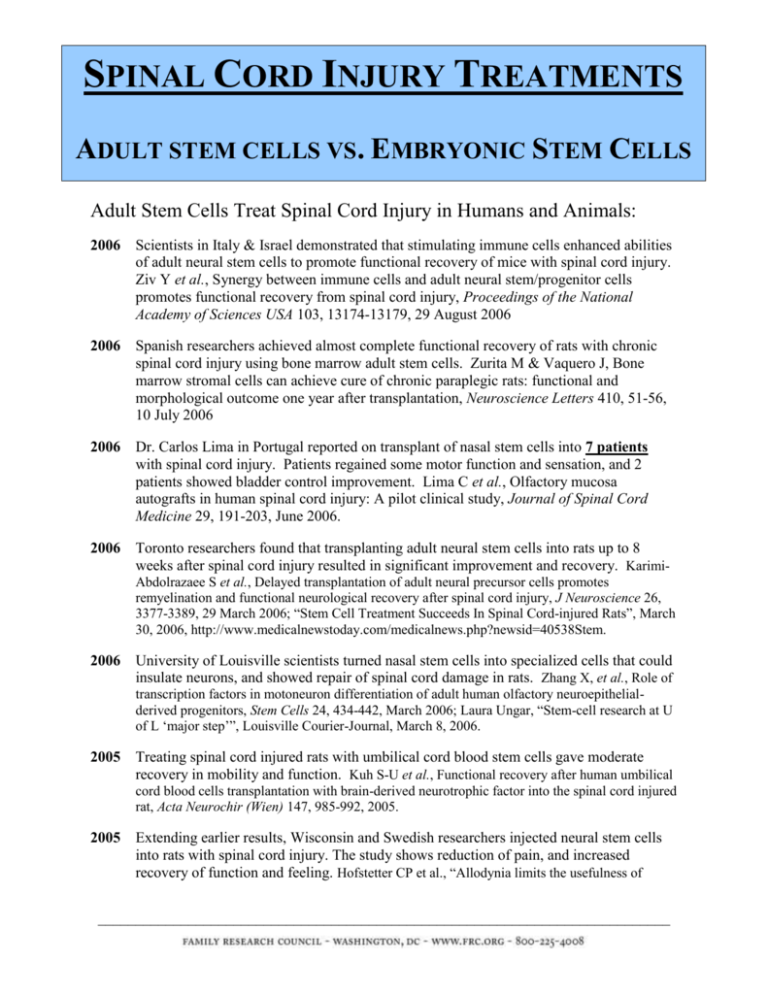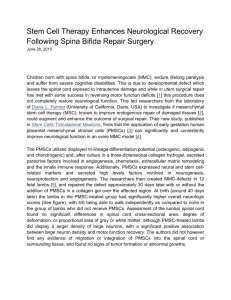sci precursor
advertisement

SPINAL CORD INJURY TREATMENTS ADULT STEM CELLS VS. EMBRYONIC STEM CELLS Adult Stem Cells Treat Spinal Cord Injury in Humans and Animals: 2006 Scientists in Italy & Israel demonstrated that stimulating immune cells enhanced abilities of adult neural stem cells to promote functional recovery of mice with spinal cord injury. Ziv Y et al., Synergy between immune cells and adult neural stem/progenitor cells promotes functional recovery from spinal cord injury, Proceedings of the National Academy of Sciences USA 103, 13174-13179, 29 August 2006 2006 Spanish researchers achieved almost complete functional recovery of rats with chronic spinal cord injury using bone marrow adult stem cells. Zurita M & Vaquero J, Bone marrow stromal cells can achieve cure of chronic paraplegic rats: functional and morphological outcome one year after transplantation, Neuroscience Letters 410, 51-56, 10 July 2006 2006 Dr. Carlos Lima in Portugal reported on transplant of nasal stem cells into 7 patients with spinal cord injury. Patients regained some motor function and sensation, and 2 patients showed bladder control improvement. Lima C et al., Olfactory mucosa autografts in human spinal cord injury: A pilot clinical study, Journal of Spinal Cord Medicine 29, 191-203, June 2006. 2006 Toronto researchers found that transplanting adult neural stem cells into rats up to 8 weeks after spinal cord injury resulted in significant improvement and recovery. KarimiAbdolrazaee S et al., Delayed transplantation of adult neural precursor cells promotes remyelination and functional neurological recovery after spinal cord injury, J Neuroscience 26, 3377-3389, 29 March 2006; “Stem Cell Treatment Succeeds In Spinal Cord-injured Rats”, March 30, 2006, http://www.medicalnewstoday.com/medicalnews.php?newsid=40538Stem. 2006 University of Louisville scientists turned nasal stem cells into specialized cells that could insulate neurons, and showed repair of spinal cord damage in rats. Zhang X, et al., Role of transcription factors in motoneuron differentiation of adult human olfactory neuroepithelialderived progenitors, Stem Cells 24, 434-442, March 2006; Laura Ungar, “Stem-cell research at U of L ‘major step’”, Louisville Courier-Journal, March 8, 2006. 2005 Treating spinal cord injured rats with umbilical cord blood stem cells gave moderate recovery in mobility and function. Kuh S-U et al., Functional recovery after human umbilical cord blood cells transplantation with brain-derived neurotrophic factor into the spinal cord injured rat, Acta Neurochir (Wien) 147, 985-992, 2005. 2005 Extending earlier results, Wisconsin and Swedish researchers injected neural stem cells into rats with spinal cord injury. The study shows reduction of pain, and increased recovery of function and feeling. Hofstetter CP et al., “Allodynia limits the usefulness of ____________________________________________________________________________ intraspinal neural stem cell grafts; directed differentitation improves outcome,” Nature Neuroscience 8, 346-353, March 2005. 2004 Japanese scientists tested the effects of bone marrow stromal cells on repair of injured spinal cord. The study demonstrated that the adult stem cells promoted both tissue recovery and behavioral improvements in rats. Ohta M et al., “Bone marrow stromal cells infused into the cerebrospinal fluid promote functional recovery of the injured rat spinal cord with reduced cavity formation,” Experimental Neurology 187, 266-278, 2004. 2003 University of South Florida and Korean researchers used human umbilical cord blood stem cells to treat rats with spinal cord injuries. They found that the cord blood stem cells migrated to areas of injury, and the rats showed significant behavioral improvements even when treated several days after the injury. Saporta S et al., “Human umbilical cord blood stem cells infusion in spinal cord injury: Engraftment and beneficial influence on behavior,” J Hematotherapy Stem Cell Research 12, 271-278, 2003. 2002 A collaboration between researchers at Tulane and in Sweden found that adult bone marrow stromal cells promote healing of spinal cord injuries, and that the cells produced significant functional improvement. The study concluded that bone marrow stromal cells are an accessible, expandable source of cells that offer a promising future for spinal cord repair. Hofstetter CP et al., “Marrow stromal cells form guiding strands in the injured spinal cord and promote recovery,” Proc Natl Acad Sci USA 99, 2199-2204, February 19, 2002. Touted ESCR Spinal Cord Injury Studies in Animals: 2006 Johns Hopkins researchers turned embryonic stem cells into motor neurons and showed some improvement in mobility of spinal cord injured rats; however, one of the factors needed for success was adult neural stem cells to provide a growth factor and migration path for the embryonic stem cells. Deshpande DM et al., Recovery from paralysis in adult rats using embryonic stem cells, Annals of Neurology 60, 32-44, 2006. 2005 California researchers used human embryonic stem cells to treat rats with new but not long-term spinal cord injury. The stem cells were turned into the nerve cells that surround spinal cords, and the rats showed modest functional improvement. The experiment was not continued long enough to test for tumors. Keirstead H et al., “Human embryonic stem cell derived oligodendrocyte progenitor cell transplants remyelinate and restore locomotion after spinal cord injury,” J Neuroscience 25, 4694-4705, May 11, 2005. 2005 Researchers at Washington University, St. Louis, found that transplanting embryonic stem cells into rat spinal cord gave no improvement, and caused tumors in a number of animals. Howard MJ et al., Transplantation of apoptosis-resistant embryonic stem cells into the injured rat spinal cord, Somatosensory and Motor Research 22, 37-44, March/June 2005. 2005 Researchers used human embryonic stem cells to remyelinate the protective sheath around injured rat spinal cords. However, there was no test for any functional recovery. Nistor GI et al., “Human embryonic stem cells differentiate into oligodendrocytes in high purity and myelinate after spinal cord transplantation,” Glia 49, 385-396, February 2005. 1999 Researchers used human embryonic stem cells in rats with spinal cord injury. The rats showed some functional improvement. McDonald JW et al., “Transplanted embryonic stem cells survive, differentiate and promote recovery in injured rat spinal cord,” Nature Medicine 12, 1410-1412, December 1999. ____________________________________________________________________________






